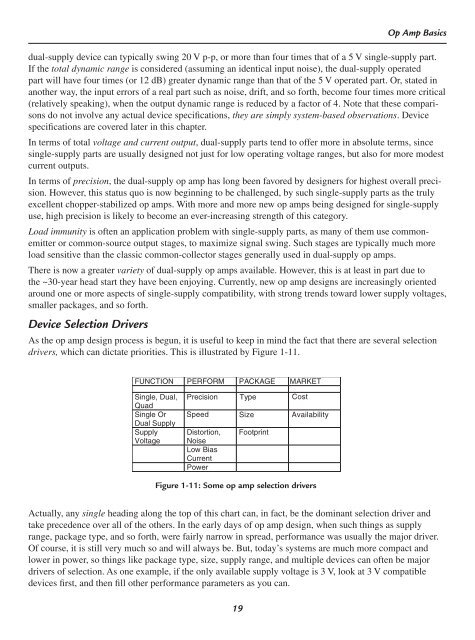Op Amp Applications Handbook Walt Jung, Editor
Op Amp Applications Handbook Walt Jung, Editor
Op Amp Applications Handbook Walt Jung, Editor
You also want an ePaper? Increase the reach of your titles
YUMPU automatically turns print PDFs into web optimized ePapers that Google loves.
19<br />
<strong>Op</strong> <strong>Amp</strong> Basics<br />
dual- supply device can typically swing 20 V p-p, or more than four times that of a 5 V single-supply part.<br />
If the total dynamic range is considered (assuming an identical input noise), the dual-supply operated<br />
part will have four times (or 12 dB) greater dynamic range than that of the 5 V operated part. Or, stated in<br />
another way, the input errors of a real part such as noise, drift, and so forth, become four times more critical<br />
(relatively speaking), when the output dynamic range is reduced by a factor of 4. Note that these comparisons<br />
do not involve any actual device specifi cations, they are simply system-based observations. Device<br />
specifi cations are covered later in this chapter.<br />
In terms of total voltage and current output, dual-supply parts tend to offer more in absolute terms, since<br />
single-supply parts are usually designed not just for low operating voltage ranges, but also for more modest<br />
current outputs.<br />
In terms of precision, the dual-supply op amp has long been favored by designers for highest overall precision.<br />
However, this status quo is now beginning to be challenged, by such single-supply parts as the truly<br />
excellent chopper-stabilized op amps. With more and more new op amps being designed for single-supply<br />
use, high precision is likely to become an ever-increasing strength of this category.<br />
Load immunity is often an application problem with single-supply parts, as many of them use commonemitter<br />
or common-source output stages, to maximize signal swing. Such stages are typically much more<br />
load sensitive than the classic common-collector stages generally used in dual-supply op amps.<br />
There is now a greater variety of dual-supply op amps available. However, this is at least in part due to<br />
the ~30-year head start they have been enjoying. Currently, new op amp designs are increasingly oriented<br />
around one or more aspects of single-supply compatibility, with strong trends toward lower supply voltages,<br />
smaller packages, and so forth.<br />
Device Selection Drivers<br />
As the op amp design process is begun, it is useful to keep in mind the fact that there are several selection<br />
drivers, which can dictate priorities. This is illustrated by Figure 1-11.<br />
FUNCTION PERFORM PACKAGE MARKET<br />
Single, Dual,<br />
Quad<br />
Single Or<br />
Dual Supply<br />
Supply<br />
Voltage<br />
Precision Type Cost<br />
Speed<br />
Distortion,<br />
Noise<br />
Low Bias<br />
Current<br />
Power<br />
Size Availability<br />
Footprint<br />
Figure 1-11: Some op amp selection drivers<br />
Actually, any single heading along the top of this chart can, in fact, be the dominant selection driver and<br />
take precedence over all of the others. In the early days of op amp design, when such things as supply<br />
range, package type, and so forth, were fairly narrow in spread, performance was usually the major driver.<br />
Of course, it is still very much so and will always be. But, today’s systems are much more compact and<br />
lower in power, so things like package type, size, supply range, and multiple devices can often be major<br />
drivers of selection. As one example, if the only available supply voltage is 3 V, look at 3 V compatible<br />
devices fi rst, and then fi ll other performance parameters as you can.






